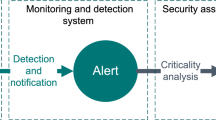Abstract
Data fusion techniques combine raw data of multiple sources and collect associated data to achieve more specific inferences than what could be attained with a single source. Situational awareness is one of the levels of the JDL, a matured information fusion model. The aim of situational awareness is to understand the developing relationships of interests between entities within a specific time and space. The present research shows how semantic web technologies, i.e. ontology and semantic reasoner, can be used to describe situations and increase awareness of the situation. As the situation awareness level receives data streams from numerous distributed sources, it is necessary to manage data streams by applying data stream processor engines such as Esper. In addition, in this research, complex event processing, a technique for achieving related situational in real-time, has been used, whose main aim is to generate actionable abstractions from event streams, automatically. The proposed approach combines Complex Event Processing and semantic web technologies to achieve better situational awareness. To show the functionality of the proposed approach in practice, some simple examples are discussed.




Similar content being viewed by others
References
White A (1987) Data Fusion Lexicon, Joint Directors of Laboratories, Technical Panel for C3. Data Fusion SubPanel, Naval Ocean Systems Center, San Diego
Llinas J, Bowman C, Rogova G, Steinberg A, Waltz E, White F (2004) Revisiting the JDL data fusion model II. Space and Naval Warefare Systems Command, San Diego
Nakamura EF, Loureiro AA, Frery AC (2007) Information fusion for wireless sensor networks: methods, models, and classifications. ACM Comput Surv (CSUR) 39(3):9
Llinas J, Hall DL (1998) An introduction to multi-sensor data fusion. In: Proceedings of the 1998 IEEE international symposium on, circuits and systems, 1998. ISCAS’98, vol 6. IEEE, pp 537–540
Boyd JR (1987) A discourse on winning and losing. Air University document MU43947, briefing, p 1
Bedworth M, O’Brien J (2000) The Omnibus model: A new model of data fusion? IEEE Aerosp Electron Syst Mag 15(4):30–36
Kokar MM, Bedworth MD, Frankel CB (2000) Reference model for data fusion systems. In: Proceedings of SPIE, the international society for optical engineering, vol 4051, pp 191–202
Frankel CB, Bedworth MD (2000) Control, estimation and abstraction in fusion architectures: lessons from human information processing. In: Proceedings of the 3rd international conference on information fusion, 2000. FUSION 2000, vol 1. IEEE, pp MOC5-3
Endsley MR (1988) Design and evaluation for situation awareness enhancement. In: Proceedings of the human factors society annual meeting, vol 32(2). SAGE Publications, Los Angeles, pp 97–101
Cugola G, Margara A (2012) Processing flows of information: from data stream to complex event processing. ACM Comput Surv (CSUR) 44(3):15
Blasch EP, Plano S (2003) Level 5: user refinement to aid the fusion process. In: Multisensor, multisource information fusion: architectures, algorithms, and applications 2003, vol 5099. International Society for Optics and Photonics, pp 288–298
Lambert DA (2001) Situations for situation awareness. In: Proceedings of fusion
Lambert DA (2003) An exegesis of data fusion. Stud Fuzziness Soft Comput 127:68–75
Blasch E, Steinberg A, Das S, Llinas J, Chong C, Kessler O et al (2013) Revisiting the JDL model for information exploitation. In: 16th international conference on information fusion (FUSION), 2013. IEEE, pp 129–136
Synnergren J, Gamalielsson J, Olsson B (2007) Mapping of the JDL data fusion model to bioinformatics. In: IEEE international conference on systems, man and cybernetics, 2007, ISIC. IEEE, pp 1506–1511
Swart I, Irwin B, Grobler MM (2016) Adaptation of the JDL model for multi-sensor national cyber security data fusion. Int J Cyber Warf Terror (IJCWT) 6(3):17–30
Giacobe NA (2010) Application of the JDL data fusion process model for cyber security. In: Proceedings of SPIE, vol 7710, p 77100R
Cruz IF, Xiao H (2005) The role of ontologies in data integration. Eng Intell Syst Electr Eng Commun 13(4):245
Wache H, Voegele T, Visser U, Stuckenschmidt H, Schuster G, Neumann H, Hübner S (2001) Ontology-based integration of information—a survey of existing approaches. In: IJCAI-01 workshop: ontologies and information sharing, vol 2001, pp 108–117
Arens Y, Hsu CN, Knoblock CA (1996) Query processing in the sims information mediator. Adv Plan Technol 32:78–93
Mena E, Illarramendi A, Kashyap V, Sheth AP (2000) OBSERVER: An approach for query processing in global information systems based on interoperation across pre-existing ontologies. Distrib Parallel Databases 8(2):223–271
Matheus CJ, Kokar MM, Baclawski K (2003) A core ontology for situation awareness. In: Proceedings of the 6th international conference on information fusion, vol 1, pp 545–552
Matheus C, Kokar M, Baclawski K, Letkowski J (2005) An application of semantic web technologies to situation awareness. Semant Web-ISWC 2005:944–958
Noughabi HA, Kahani M, Behkamal B (2013) SemFus: semantic fusion framework based on JDL. In: Innovations and advances in computer, information, systems sciences, and engineering. Springer, New York, pp 583–594
Golab L, Özsu MT (2010) Data stream management. Synth Lect Data Manag 2(1):1–73
Luckham D (2008) The power of events: an introduction to complex event processing in distributed enterprise systems. In: International workshop on rules and rule markup languages for the semantic web. Springer, Berlin pp 3–3
ESPERTECH (2015) Event processing with Esper and NEsper. http://esper.codehaus.org
Author information
Authors and Affiliations
Corresponding author
Rights and permissions
About this article
Cite this article
Noughabi, H.A., Kahani, M. & Shakibamanesh, A. Enhancing Situation Awareness Using Semantic Web Technologies and Complex Event Processing. Ann. Data. Sci. 5, 487–496 (2018). https://doi.org/10.1007/s40745-018-0148-1
Received:
Revised:
Accepted:
Published:
Issue Date:
DOI: https://doi.org/10.1007/s40745-018-0148-1




